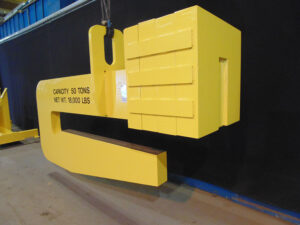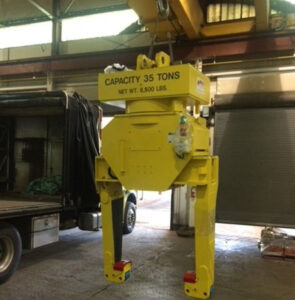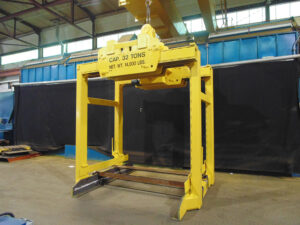In steel mills and steel service centers, lifting heavy materials is a regular and essential task. Integrating a below-the-hook lifting device can significantly improve your facility’s safety, efficiency, and productivity.
Specialized lifting equipment, below-the-hook devices are designed to handle loads of differing sizes and shapes, providing versatile solutions for moving steel coils and sheets. Choosing the right device for your operation requires a basic understanding of the options available. Below, we explore some of the most commonly used below-the-hook lifting devices, focusing on their strengths, weaknesses, and ideal applications in steel production.
C-Hooks

C-hooks are shaped like a “C” with a counterweight at the end of it and are designed to lift and transport the coil’s eye horizontally. The horn of the C-hook fits directly through the bore of the coil, allowing for quick, secure lifting. C-hooks are operated by personnel on the floor.
Strengths
- Efficient for Lifting Coils: C-hooks are ideal for lifting steel coils. Their simple design allows for easy securing of the coil, enabling swift transportation within the facility.
- Minimal Handling: The C-hook can handle the coil without the need for additional slings or hooks, reducing setup time and enhancing workflow efficiency.
- Heavy-Duty Capabilities: C-hooks are built to lift substantial weights, making them ideal for heavy-duty applications where coils can weigh several tons.
Weaknesses
- Limited Use: While highly effective for coils, C-hooks are not suitable for handling any other materials such as sheets or plates.
- Requires Proper Coil Positioning: The coil must be horizontally positioned to ensure a safe balanced load when being transported.
Ideal Applications
- Steel Coils: Perfect for facilities where coils are a primary material, such as in steel mills or steel service centers.
- Transporting Rolled Goods: In addition to steel, C-hooks can handle other coiled materials like aluminum or copper.
Coil Grabs

Coil grabs (or coil lifters) are another commonly used device for handling steel coils. Unlike C-hooks, coil grabs are motorized and work by clamping onto the outer width of the coil and picking it up by the bore. The coil grabs are operated by personnel on the floor or in a crane cab, but can also be automated.
Strengths
- Versatility: Coil grabs are adjustable meaning they can handle coils of varying widths and diameters, providing more flexibility compared to C-hooks.
- Enhanced Safety: Motorized and automated models reduce manual intervention, improving safety by minimizing the need for workers to be close to the lifting area.
Weaknesses
- More Complex Design: Coil grabs are more mechanically complex than C-hooks, leading to potentially higher maintenance costs.
- Higher Initial Cost: Motorized or automated coil grabs often come with a higher price tag than simpler devices like C-hooks.
Ideal Applications
- Multiple Coil Sizes: Best suited for operations that deal with coils of various widths as the adjustable nature of coil grabs allows for greater flexibility.
- Coil Storage and Loading: Often used in steel mills, steel service centers and warehouses for loading coils onto transport vehicles or storage.
Sheet Lifters

Sheet lifters are designed to move large, flat materials such as steel plates or sheets. These devices are motorized and equipped with long arms that slide under or clamp onto the edges of the sheet, allowing them to lift it securely. Sheet lifters are operated by personnel on the floor.
Strengths
- Perfect for Flat Materials: Sheet lifters are tailored to handling large, flat pieces of material that would be difficult or dangerous to move manually.
- Safe, Secure Grip: These devices provide a firm grip, ensuring the sheet or plate remains steady during transport, reducing the risk of accidents.
- Customizable: Sheet lifters can be customized to fit different sheet sizes and weights, making them adaptable to your facility’s specific needs.
Weaknesses
- Limited to Flat Materials: While ideal for sheet handling, sheet lifters are not designed to lift rounded or irregularly shaped objects.
- Requires Careful Handling: Large sheets can be awkward to maneuver, and improper use of sheet lifters can lead to damage or accidents.
Ideal Applications
- Steel Production: Commonly used for transporting steel plates or other flat materials within steel production and steel service centers.
- Construction Material Handling: Ideal for facilities dealing with large sheets of material, including aluminum, steel, or other metals.
Choosing the Right Lifting Device for Your Facility
When selecting a below-the-hook lifting device for your facility, it’s important to consider the type of material you handle, the shape and weight of the load, and your operational workflow. Avon Engineering has extensive experience in assisting steel production operations with selecting and customizing lifting solutions for their specific process needs and facility. Contact our team to discuss your operation and lifting needs.

